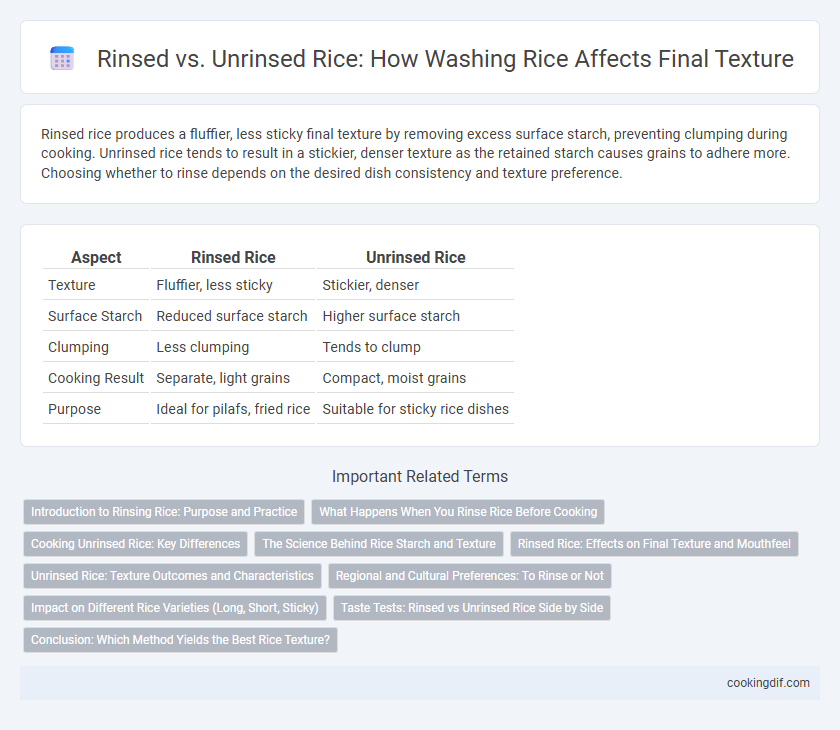Rinsed rice produces a fluffier, less sticky final texture by removing excess surface starch, preventing clumping during cooking. Unrinsed rice tends to result in a stickier, denser texture as the retained starch causes grains to adhere more. Choosing whether to rinse depends on the desired dish consistency and texture preference.
Table of Comparison
| Aspect | Rinsed Rice | Unrinsed Rice |
|---|---|---|
| Texture | Fluffier, less sticky | Stickier, denser |
| Surface Starch | Reduced surface starch | Higher surface starch |
| Clumping | Less clumping | Tends to clump |
| Cooking Result | Separate, light grains | Compact, moist grains |
| Purpose | Ideal for pilafs, fried rice | Suitable for sticky rice dishes |
Introduction to Rinsing Rice: Purpose and Practice
Rinsing rice removes surface starch, preventing grains from sticking and resulting in a fluffier, separated texture after cooking. Unrinsed rice retains more starch, often producing a stickier, clumpier consistency preferred in certain dishes like sushi or risotto. The rinsing process involves repeatedly washing rice under cold water until the runoff is clear, balancing cleanliness with the desired final texture.
What Happens When You Rinse Rice Before Cooking
Rinsing rice removes excess surface starch, preventing grains from becoming sticky and clumping together during cooking, resulting in a fluffier texture. Unrinsed rice retains this starch, which can cause a denser, stickier final dish, ideal for recipes like sushi or risotto where a creamy texture is desired. Water quality and rinsing duration also influence the final rice texture by affecting hydration and starch removal.
Cooking Unrinsed Rice: Key Differences
Cooking unrinsed rice often results in a stickier and softer texture due to the retained surface starch, which helps grains bind together more during the cooking process. Unlike rinsed rice, unrinsed rice absorbs water differently, leading to less grain separation and a slightly creamier consistency. Understanding these differences is crucial for recipes where texture plays a pivotal role, such as sushi or risotto.
The Science Behind Rice Starch and Texture
Rinsed rice removes surface starch, reducing starch granules that cause clumping, resulting in a fluffier, less sticky texture. Unrinsed rice retains more amylopectin and amylose on the surface, which gelatinize during cooking to create a stickier, denser consistency. The balance between these starch molecules and their gelatinization directly influences the final texture, with rinsing altering the starch profile to favor separate, distinct grains.
Rinsed Rice: Effects on Final Texture and Mouthfeel
Rinsed rice removes excess surface starch, resulting in grains that remain separate and less sticky after cooking, which enhances the final texture and mouthfeel. This process produces a firmer, fluffier texture ideal for dishes requiring distinct grains, such as pilafs or fried rice. In contrast, unrinsed rice retains more starch, leading to a creamier and stickier texture, affecting the overall eating experience.
Unrinsed Rice: Texture Outcomes and Characteristics
Unrinsed rice retains surface starches that contribute to a stickier, creamier texture, ideal for dishes like risotto or sushi. The presence of these starches enhances the rice's binding properties but can also lead to clumping or uneven cooking if not managed properly. Cooking unrinsed rice requires precise water ratios and heat control to achieve a tender yet cohesive final texture.
Regional and Cultural Preferences: To Rinse or Not
Rinsed rice typically yields a fluffier and less sticky final texture, preferred in cultures such as Japanese and Korean cuisines where individual grains are desirable. In contrast, unrinsed rice retains more surface starch, resulting in a stickier, more cohesive texture favored in South Asian and some Southern American dishes for traditional recipes. Regional culinary practices strongly influence whether rice is rinsed or not, aligning cooking methods with cultural texture preferences.
Impact on Different Rice Varieties (Long, Short, Sticky)
Rinsed rice typically removes surface starch and impurities, resulting in a fluffier texture ideal for long-grain varieties like Basmati and Jasmine, which benefit from separated, non-clumpy grains. Unrinsed rice retains more starch, producing a stickier, creamier texture preferred for short-grain and sticky rice varieties, commonly used in sushi and Asian dishes. The choice between rinsed and unrinsed rice significantly affects the final mouthfeel and cohesiveness, aligning with the inherent characteristics of each rice type.
Taste Tests: Rinsed vs Unrinsed Rice Side by Side
Rinsed rice typically produces fluffier, less sticky grains by removing surface starch, enhancing texture and overall mouthfeel in taste tests. Unrinsed rice often yields a creamier, more cohesive texture due to retained starch, which some prefer for dishes like risotto or sushi. Side-by-side comparisons reveal rinsed rice excels in light, separated grain appeal, while unrinsed rice offers richer, stickier consistency favored in certain culinary traditions.
Conclusion: Which Method Yields the Best Rice Texture?
Rinsed rice removes surface starch, resulting in fluffier, less sticky grains perfect for dishes requiring separate kernels, while unrinsed rice retains starch, producing a stickier, creamier texture ideal for sushi or risottos. Texture preferences depend on the culinary application, but rinsing generally yields a cleaner, more distinct grain structure favored in most cooking methods. Choosing the best method aligns with the desired final dish texture, making rinsed rice the optimal choice for fluffy rice and unrinsed rice preferable for sticky or creamy preparations.
Rinsed rice vs Unrinsed rice for final texture Infographic

 cookingdif.com
cookingdif.com